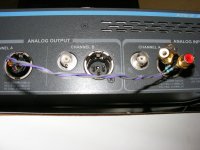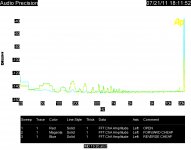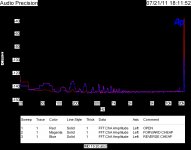you can overcome it easily. if the speakers are in the correct space.
if you have a decent comp with a good graphic eq on its sidechain, you can fix alot of bad mic use.
but bad mic use is bad mic use.
Gain structure + compession + microphone selection is the major ingredients
and don't over eq your monitors, that leads to mud land.
In Arena sports use there are no monitors. If they have hired an announcer for real money, who can't use a mic properly, the correct approach is to replace them. Compression is fine for increasing intelligibility over noise. The problem with room reverb is that compression reduces the peak level and raises the average level. A good announcer will speak around four syllables per second. So in a room with a mid frequency reverb time of three seconds that would allow for 5 db of decay which is just enough to get good recognition. If you compress you lose that peak!
So where a compressor works well for singing, it does not do well on plain old speech if the issue is room reverb. For noise then running the signal level up without blowing up loudspeakers is just the ticket.
A large stadium system can do 105 db at 800 feet. Arenas only need to do that at 200 feet. A loud rock concert is 110 at 100 feet. A legal rock concert is 102 at 100 feet.
I was under the impression he was referring to a blood pump to be used in an operating room. The unit on display was a blood pump converted in order to demonstrate the technology, although it wasn't clear whether it was being marketed as a blood pump.
John
You're right, I stand corrected...I forgot about in the operating room..duh..
I watched it again, it was interesting to watch the interviewer's facial expressions during the Q and A. Clearly he was supposed to ask specific technical questions, and had to keep a straight face as the answers given didn't match the questions...
Cheers, John
Well I took two XLR inserts and made an adapter for my AP System 2. The female has a 62 ohm 1/4W 1% MF resistor going from pin 2 to the males pin 2. Pin 3 of the female also goes through a matching (.1%) resistor to pin 3 of the male. Attached to pin 2 of the male is an RCA jack the same as pin 3. Both jacks are grounded to pin 1 of the male.
John if you prefer I can easily change the grounding.
Attached is a picture of the setup.
John if you prefer I can easily change the grounding.
Attached is a picture of the setup.
Attachments
So I set the output to .03 volts at 19 & 20 khz at a ratio of 1/1.
I averaged 32 fft's of the adapter open, shorted with a cheap RCA cable and then with the same cable reversed.
Here is the result. (Colors get messed up in translation)
So what is interesting in these plots?
I averaged 32 fft's of the adapter open, shorted with a cheap RCA cable and then with the same cable reversed.
Here is the result. (Colors get messed up in translation)
So what is interesting in these plots?
Attachments
OK, so it's completely unremarkable. No significant difference in cable direction, and noise pickup from the loop down in the realm where newborns couldn't hear it.
Nice intermod performance of the test rig!
So you like going out on a limb! What do you think happens with standard 1K THD?
Sy,
attached color not reversed.
What I find interesting is that everything seems to be correlated with the red line, albeit at somewhat elevated level. Looks like you are measuring something in the machine that gets amplified by this setup. But it is already there. So EMR is the most likely explanation to me.
vac
OK, so it's completely unremarkable. No significant difference in cable direction, and noise pickup from the loop down in the realm where newborns couldn't hear it.
Nice intermod performance of the test rig!
I agree nothing but trivial changes and nothing much but mains harmonics.
I agree nothing but trivial changes and nothing much but mains harmonics.
Exactly! There is nothing showing up! The interesting issue is how low the 60hz harmonics are! You have to look lower than this to see any interesting effects. There is no IM showing up at these levels.
So to me this is a good baseline. If there were say a 1K or other frequency showing up that would be an IM product a skilled user would pick that out and ask if it were from the test setup or the device under test. If you did THD then you would might look for different frequencies, but you would ignore the 60hz junk.
So if you want to look for interconnect distortion you need to look lower!
That raises the very valid issue of who actually hears stuff that low? Is there some actual application issue that makes stuff that low more important? Etc?
Personally I think using high impedance loads with high gain on small signals makes the problem worse. I expect to see interesting stuff about 20 to 30 db below the levels shown. So The question of why don't you see these cable distortions on an AP is I think answered by the limits of the test.
If everything is testing the same then your test probably is not sensitive enough!
- Status
- Not open for further replies.
- Home
- Member Areas
- The Lounge
- John Curl's Blowtorch preamplifier part II



